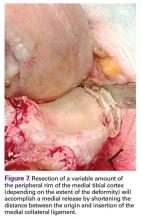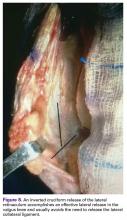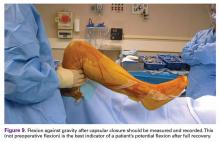An Inverted Cruciform Lateral Retinacular Release to Correct Severe Valgus Deformity
An inverted cruciform lateral retinacular release effectively corrects a severe valgus deformity and avoids the need for a lateral collateral ligament (LCL) release.7
The release is best done after bone resection but without trial components in place, because this facilitates exposure to the lateral retinaculum (Figure 8). The lateral superior genicular vessels should be identified and preserved. The vertical part of the release begins distal to the vessels and ends at the tibial resection. The horizontal limbs extend posteriorly short of the LCL and anteriorly short of the patellar tendon. If the extent of this release does not sufficiently balance the knee, it can be propagated by placing trial components with an insert thickness that stabilizes the medial side. Under this circumstance, the tight lateral side will now prohibit full passive extension. With gentle manipulation of the knee into extension, the lateral release will be propagated to its appropriate length. Postoperative perineal nerve palsies are rare with this technique. Immediate postoperative assessment, however, should always be done and the patient’s dressing loosened and their knee placed in flexion if there is any concern. Almost all of these rare palsies make a complete recovery.Relieving Posterior Femoral Impingement
Uncapped posterior condylar bone or retained posterior osteophytes can limit both flexion and extension and cause impingement. Trimming the posterior femoral condyles and removing posterior osteophytes is best accomplished using a trial femoral component as a template.4 A curved osteotome is passed tangential to the metallic condyles to define the bone requiring resection. After removal of the trial, the outlined bone can be easily and accurately resected.
Minimizing Postoperative Posterior Condylar Bone-Cement Radiolucencies
Zone 4 femoral bone-cement radiolucencies8 can be minimized using the “smear” technique.4 These radiolucencies are common because most prosthetic femoral components have posterior condyles that are parallel to the femoral fixation lugs and do not allow for compression of this interface during implantation. Most surgeons put no cement on the posterior condylar bone but place it on the inside of the prosthetic condyle instead. The lack of compression upon insertion leads to a poor interface and the resultant lucencies. In the long term, these lucencies could allow access of wear debris to the posterior condylar bone, with the potential for osteolysis and loosening. To improve this interface, cement can be smeared or packed into the posterior condyles and also placed on the posterior condyles of the prosthesis. This could lead to posterior extrusion of some cement during polymerization, so a removable trial insert should be utilized to allow access posteriorly after polymerization is complete.
Predicting Potential Postoperative Flexion
The best indicator of potential postoperative flexion for any individual patient is not preoperative flexion but is intraoperative flexion against gravity measured after capsular closure.9 Surgeons should measure and record this value for reference if a patient has difficulty regaining flexion during their recovery (Figure 9).
If a patient had 120° of flexion against gravity after capsular closure but achieves only 80° at 2 months, a knee manipulation is probably indicated. If their flexion after closure was only 80°, a manipulation is unlikely to lead to any improvement.Summary
The short- and long-term success of TKA is highly dependent on surgical technique that allows proper and safe exposure under all circumstances, correction of deformity, and accurate component implantation while minimizing intraoperative and postoperative complications. The surgical pearls shared above will hopefully aid in achieving these goals.
Am J Orthop. 2016;45(6):384-388. Copyright Frontline Medical Communications Inc. 2016. All rights reserved.



